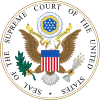| Silverthorne Lumber Co. v. United States | |
|---|---|
 | |
| Argued December 12, 1919 Decided January 26, 1920 | |
| Full case name | Silverthorne Lumber Co., Inc., et al. v. United States |
| Citations | 251 U.S. 385 (more) 40 S. Ct. 182; 64 L. Ed. 319; 1920 U.S. LEXIS 1685 |
| Holding | |
| To permit derivatives would encourage police to circumvent the Fourth Amendment, so the illegal copied evidence was held tainted and inadmissible. | |
| Court membership | |
| |
| Case opinions | |
| Majority | Holmes, joined by McKenna, Day, Van Devanter, McReynolds, Brandeis, Clark |
| Dissent | White |
| Dissent | Pitney |
Silverthorne Lumber Co. v. United States, 251 U.S. 385 (1920), was a U.S. Supreme Court Case in which Silverthorne attempted to evade paying taxes. Federal agents illegally seized tax books from Silverthorne and created copies of the records. The issue in this case is whether or not derivatives of illegal evidence are permissible in court. The ruling, delivered by Oliver Wendell Holmes, Jr., was that to permit derivatives would encourage police to circumvent the Fourth Amendment, so the illegal copied evidence was held tainted and inadmissible.[1] This precedent later became known as the "fruit of the poisonous tree doctrine,"[2] and is an extension of the exclusionary rule.
Chief Justice White and Associate Justice Pitney dissented without a written opinion.
See also
- List of United States Supreme Court cases, volume 251
- Wong Sun v. United States, 371 U.S. 471 (1963)
Further reading
- Killian, B. J. (1982). "United States v. Crews: Fruit of the Poisonous Tree—A New Wrinkle?". Idaho Law Review. 18: 151. ISSN 0019-1205.
References
External links
 Works related to Silverthorne Lumber Company v. United States at Wikisource
Works related to Silverthorne Lumber Company v. United States at Wikisource- Text of Silverthorne Lumber Co. v. United States, 251 U.S. 385 (1920) is available from: CourtListener Findlaw Google Scholar Justia Library of Congress